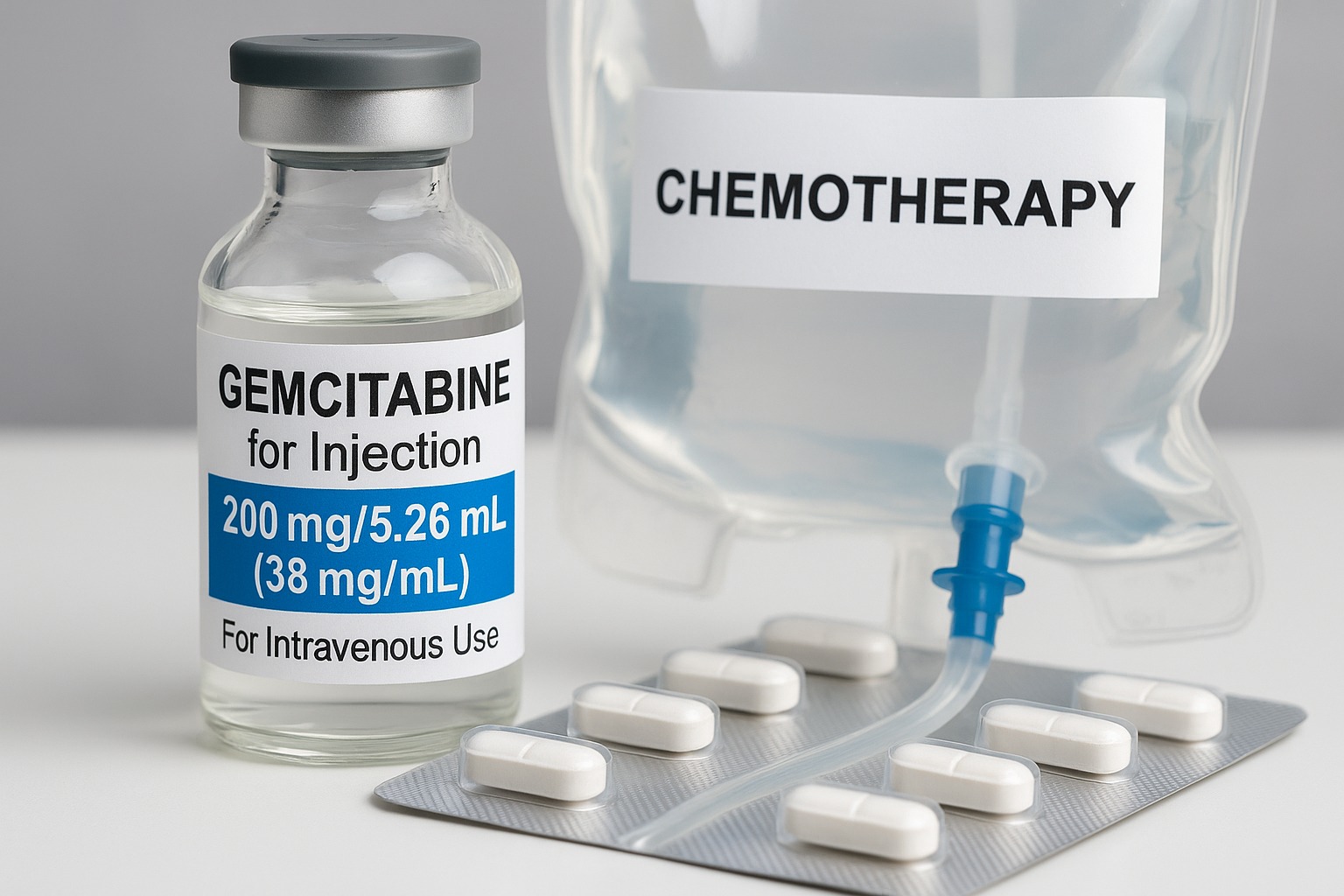Gemcitabine is a prescription chemotherapy drug used to treat several cancers. Its brand name is Gemzar, and it belongs to a class of medicines called antimetabolites. Gemcitabine works by interfering with DNA replication, which slows or stops the growth of cancer cells.
Doctors often use Gemcitabine alone or in combination with other chemotherapy drugs such as cisplatin, carboplatin, or docetaxel. It is given by intravenous (IV) infusion in a clinic or hospital setting, not at home.
In this easy-to-read guide, you’ll learn what Gemcitabine is, how it works, when doctors prescribe it, how treatment is given, possible side effects, safety tips, and answers to frequently asked questions (dose schedules, infusion times, combination regimens, cost/assistance, and more).
Disclaimer: This article is for educational purposes only. It is not a substitute for professional medical advice. Always follow your oncology team’s instructions.
What Is Gemcitabine?
- Brand name: Gemzar
- Generic name: Gemcitabine
- Drug type: Antimetabolite chemotherapy
- Form: Sterile solution for intravenous infusion
Gemcitabine is not a targeted therapy or immunotherapy. It is a traditional chemotherapy drug that attacks rapidly dividing cells.
How Does Gemcitabine Work?
Cancer cells divide quickly, which makes them vulnerable to drugs that disrupt DNA synthesis. Gemcitabine:
- Enters cancer cells and mimics a normal building block of DNA.
- Blocks DNA replication, stopping cells from dividing.
- Leads to cancer cell death.
Because chemotherapy cannot distinguish perfectly between cancer cells and healthy rapidly dividing cells, side effects can occur in tissues like bone marrow, hair follicles, and the digestive system.
Common Uses of Gemcitabine
Doctors prescribe Gemcitabine for several FDA- and guideline-approved indications:
1. Non–Small Cell Lung Cancer (NSCLC)
- Often combined with cisplatin or carboplatin.
- Used as first-line treatment for advanced or metastatic disease.
2. Pancreatic Cancer
- Given alone or sometimes with nab-paclitaxel.
- A standard treatment for locally advanced or metastatic pancreatic cancer.
3. Bladder Cancer
- Frequently combined with cisplatin as a standard regimen.
- May also be used intravesically (directly into the bladder) in certain cases.
4. Breast Cancer
- Used with paclitaxel or other agents in metastatic disease.
5. Ovarian Cancer
- May be combined with carboplatin for recurrent disease.
Gemcitabine Dosage and Administration
Your oncologist sets the exact dose and schedule based on your diagnosis, blood counts, and overall health. Typical guidelines include:
- IV infusion: Administered over about 30 minutes in a clinic or hospital.
- Cycles: Given once a week for 2–3 weeks, followed by a rest period.
- Combination therapy: Dosing may change if paired with cisplatin, carboplatin, or docetaxel.
Premedication: Not always required, but anti-nausea medicines may be given before treatment.
Side Effects of Gemcitabine
Common Side Effects
- Fatigue and weakness
- Nausea and vomiting
- Fever or flu-like symptoms
- Low blood counts (white cells, red cells, platelets)
- Rash or mild skin reactions
- Shortness of breath or cough
- Swelling in hands, feet, or ankles
Serious Side Effects (call your doctor immediately)
- Severe infections due to low white blood cells
- Unusual bleeding or bruising
- Liver or kidney problems (yellow skin/eyes, dark urine, decreased urination)
- Lung problems (new or worsening shortness of breath, cough)
- Rare but serious capillary leak or hemolytic uremic syndrome
Safety Tips With Gemcitabine
- Infection risk: Wash hands often, avoid sick contacts, and report fevers ≥38°C (100.4°F).
- Blood counts: Regular monitoring is required before each dose.
- Pregnancy & breastfeeding: Gemcitabine can harm an unborn baby. Use effective contraception during treatment and for a period after. Breastfeeding is not recommended.
- Kidney & liver monitoring: Regular blood tests help ensure organs are functioning properly.
- Other medicines: Always share your medication list with your oncologist.
Gemcitabine vs. Other Treatments
- Compared to targeted therapy or immunotherapy: Gemcitabine works broadly on dividing cells rather than targeting specific mutations.
- Combination regimens: It is often paired with cisplatin, carboplatin, or docetaxel for stronger outcomes.
- Used in multiple cancers: Unlike some drugs restricted to one type, Gemcitabine is used across lung, pancreas, bladder, breast, and ovarian cancers.
Cost and Access
- Gemcitabine is a prescription-only infusion drug.
- Costs depend on country, insurance, and whether brand (Gemzar) or generic is used.
- Many health systems, insurance providers, or pharmaceutical programs may provide financial assistance.
Frequently Asked Questions (FAQs)
Q1. How long does a Gemcitabine infusion take?
Usually about 30 minutes, but times may vary.
Q2. How often is Gemcitabine given?
Typically once weekly for 2–3 weeks in a 3- or 4-week cycle, depending on cancer type.
Q3. What if I miss a dose?
Your oncology team will reschedule or adjust your plan. Do not self-adjust.
Q4. Can Gemcitabine cure cancer?
It is not considered a cure, but it can shrink tumors, improve survival, and relieve symptoms.
Q5. Is Gemcitabine strong chemotherapy?
Yes, Gemcitabine is a widely used cytotoxic chemotherapy with significant but manageable side effects.
Final Thoughts
Gemcitabine (Gemzar) is a versatile chemotherapy drug used to treat multiple cancers, either alone or in combination with other medicines. By blocking DNA replication, it can slow cancer growth and extend survival in diseases like pancreatic, lung, bladder, breast, and ovarian cancers.
The key to successful treatment is regular monitoring, timely reporting of side effects, and close collaboration with your oncology care team.


Leave a Comment